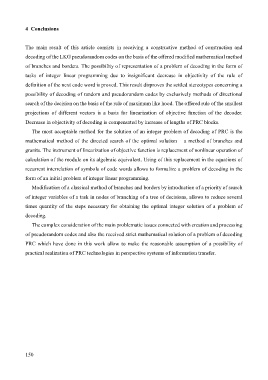Page 150 - ISCI’2017
P. 150
4 Conclusions
The main result of this article consists in receiving a constructive method of construction and
decoding of the LKG pseudorandom codes on the basis of the offered modified mathematical method
of branches and borders. The possibility of representation of a problem of decoding in the form of
tasks of integer linear programming due to insignificant decrease in objectivity of the rule of
definition of the next code word is proved. This result disproves the settled stereotypes concerning a
possibility of decoding of random and pseudorandom codes by exclusively methods of directional
search of the decision on the basis of the rule of maximum like hood. The offered rule of the smallest
projections of different vectors is a basis for linearization of objective function of the decoder.
Decrease in objectivity of decoding is compensated by increase of lengths of PRC blocks.
The most acceptable method for the solution of an integer problem of decoding of PRC is the
mathematical method of the directed search of the optimal solution – a method of branches and
granits. The instrument of linearization of objective function is replacement of nonlinear operation of
calculation of the module on its algebraic equivalent. Using of this replacement in the equations of
recurrent interrelation of symbols of code words allows to formalize a problem of decoding in the
form of an initial problem of integer linear programming.
Modification of a classical method of branches and borders by introduction of a priority of search
of integer variables of a task in nodes of branching of a tree of decisions, allows to reduce several
times quantity of the steps necessary for obtaining the optimal integer solution of a problem of
decoding.
The complex consideration of the main problematic issues connected with creation and processing
of pseudorandom codes and also the received strict mathematical solution of a problem of decoding
PRC which have done in this work allow to make the reasonable assumption of a possibility of
practical realization of PRC technologies in perspective systems of information transfer.
150

